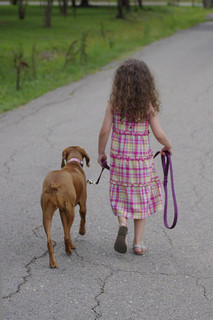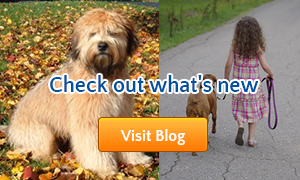 There are many things in life that have a collateral effect. What I mean is that you do one thing with one intent but you get other, unintended, consequences as a result. When you teach your dog to properly walk on a leash this often has many collateral effects. The following article will outline those and give you several reasons why you want your dog to have great leash manners and how it will effect so many other areas of your dog training efforts.
There are many things in life that have a collateral effect. What I mean is that you do one thing with one intent but you get other, unintended, consequences as a result. When you teach your dog to properly walk on a leash this often has many collateral effects. The following article will outline those and give you several reasons why you want your dog to have great leash manners and how it will effect so many other areas of your dog training efforts.
Leash Manners To Fix Destruction?
You may be asking yourself how teaching your dog to walk on a leash could possibly help your dog stop digging or chewing. The answer is that when your dog is walking in a focused walk (right by your side, paying attention, no pulling, no cheating out of position, etc.) he or she is required to think. Not only to think but to pay attention, to focus, to really make sure that he or she is watching you like a hawk.
This level of focus takes a lot out of a dog. Think about it, when are you often the most tired? Sure, you get tired when you go for a jog, a bike ride, or a hike. But when are you the most tired where you don’t want to do a thing? Where the thought of getting off the couch is painful and causes a panic attack? For most people that level of exhaustion is only attained when they are MENTALLY tired. It’s usually after a long day of work, a day of trying to figure out your taxes, a late-night cram session, or other mentally taxing activity.
The same is true for your dog. Your pup needs exercise. You need to be playing fetch, running around, and doing other physical activities. The real exhaustion for your dog, though, is going to come when the brain gets worked. Too many dogs rarely get a good mental workout. It’s almost as if we’ve created a nation of canine ‘mush brains’ because we never challenge our dogs mentally.
Guess what happens when an intelligent dog with a lot of energy does not get to a level of mental exhaustion regularly? You guessed it. That dog is much more prone to digging up your yard, chewing up your stuff, and otherwise finding ways to destroy all your nice and expensive stuff.
A dog who is taught to walk on a leash properly is getting a mental workout often and is much less likely to be destructive.
Leash Walking To Gain Leadership?
Have you ever gone online and asked Mr. Google how to be ‘dominant’ over your dog or how to ‘be the alpha’? The types of answers you’ll find are insane.
Other trainers will recommend you growl at your dog, flip your dog on his back, bite your dog, etc.
All of these ideas are pure craziness. Your dog does not view you as a big, hairless canine. When you try acting like a dog you end up looking like a fool.
What DOES help you achieve leadership and respect from a dog is obedience training. Think about it, if your dog comes when called he’s putting your will first. If your dog stays when told she’s putting your will first. When he walks properly on leash he’s doing as you asked him.
Proper leash walking puts your dog in a position where he is a follower, where she is paying attention to you, where he is focusing on you and your commands.
In case there is any confusion, those are good things. When your dog walks perfectly on leash you will find that your dog starts respecting you in lots of other areas as well.
On Leash Training To Fix Aggression?
For dogs that are aggressive one of the best things we can do is train them to walk on a leash perfectly.
This is part from the relationship aspect that I’ve already mentioned but also from a logistical standpoint.
Your dog can’t lunge at other people if she’s walking perfectly on leash. Your dog can pass by people, dogs, cats, and kids with no problem if he is heeling like a champion.
In fact, in 90% of the cases when I’m working with an aggressive dog for the first time our first order of business is to start working on great leash walking.
In summary, there is a major difference between a dog who will walk on a leash and a dog who heels perfectly. When you’ve got a dog who heels perfectly you are in a better position to fix destruction, aggression, and leadership problems.
Image Credit: Monkey Mash Button








24 Responses to “Teach a Dog to Walk on a Leash”
my two months old puppy is usually cratting undre my bed or on floor while i want her to do that in the bathroom..so i want your help.Is there any way to make her go to the bathroom?
Unfortunately, I can’t understand your question.
I think he means “crapping.” However, I wouldn’t want a dog to defecate in my bathroom. I would want a dog to go outside. And how that relates to leash training is beyond me.
Thanks for the tips! We just recently got a new puppy for the family, but I want it to be very well behaved if we ever take it out in public. I’m not going to lie and say I’m excited to start the training process but maybe I’ll find some unique dog collars or something to help make it fun. We can train and be in style!
i have a golden retriever and she is such a perfect little angel in the house, can sometimes be hyper but for the most part shes calm. trying to walk her and play with her and train her and have her focus is another question. i feel like i dont really mentally challenge her but at the same time i cant get her to focus in order for her to have her follow me with or without leash… and god forbid i take her off leash at the dog part… i end up running a good two miles chasing her chasing other dogs or birds…. please help. she listens to me inside the house but looks for my boyfriend when walking…???
Have you checked out all our videos on loose leash walking, coming when called, etc.?
No I’m sorry
Wow that was strange. I just wrote an incredibly long comment but after I clicked submit my comment
didn’t show up. Grrrr… well I’m not writing all that over again.
Anyways, just wanted to say great blog!
My Cane Corso is now two we got her when she was 15 months she has been physically abused and was starved to skin and bone at one point. When we got her she was gentle when being walking, now, not so much. I am starting to walk her with my 14 month old pittbull american staffordshire mix so that my fiance and I can have a nice walk together with them and spend time we usually don’t have in the day. When they are seperate the cane corso will still pull and get excited when she sees another small animal, I almost feel like I’m yelling at her and tugging to hard, when I tell her to heal. When we walk them together she always wants to be in front and she still pulls. I walk the cane corso with a thick nylon collar around her neck and the pittbull I walk with a harness with the leash hooked in front which works ten times better when she walks. I’m almost temped to get the cane corso a harness to see if that will work. I’m unsure of what I should do at this point.
I don’t see a harness helping. Harnesses teach dogs to pull.
have a 3 month old lab mix puppy. when trying to walk he jumps up on my and bites at the leash then dragging me ahead. when i stop to try and correct him i tell him to sit (ofcourse he doesnt do it) i go to push his butt down he goes for my hand. i trying to manage keeping his mouth away from my hand with the leash and him squirming around not keeping his butt down when i place him in sit position next to me. im sure u can imagine the chaos. blah hes just not getting it. you have any tips?
Oh, puppies. They sure are a handful. My only tip is to keep working and give it time. There are certainly exceptions but I find that most of our clients finally get a good ‘heel’ at around 5 to 6 months of age. You’re battling a bit of a puppy problem now. Keep working, though, and you’ll see progress.
hi there l have always had rescue rottweilers an they have been so easy to train, so loyal an obidient, however after losing my last boy l was devasted an thought maybe l needed a change, l started looking at rescues an came across a young boy that took my eye, 4mth old 1/4 rotti 3/4 dogue de bordeaux very handsome fella. he’s now 10 mths an jeez l,m finding it so hard he doesnt listen at all when we’re out. it started off very well l could take him an our other dog out an they’d run free, l,d have some treats in my pocket an he would stay with me or if he went for run he would come back, but unfortunately our other dog has started doing runners, l think because he doesnt have my rotti to keep him in order, and of course pup just follows, so now l,m scared to let them off at all. l am trying to walk properly on lead but he’s so strong an ignorant. l did try a harness but he just leans on it, l,ve tried a halti which he hates an just throws himself on the floor an doesnt want to go out, my other dog, 14mth huskador,[huskyxlab] he has a half choke collar, but not sure whats best for the DDB? l,ve been so sucsessful with my rotti’s feel at a loss with this little chunk! he weighs around 85lbs now so really want to sort it out b4 he gets even bigger an stronger! would appreciate your advice thanks
he weighs around 85lbs now so really want to sort it out b4 he gets even bigger an stronger! would appreciate your advice thanks
Here are a couple tips:
- Don’t use a harness. Ever. This is the worst dog training tool in the world. They actually train a dog to pull on the leash.
- Treat training doesn’t work very well. Nearly every dog arrives at a point pretty quickly where he realizes distractions are more fun than treats.
- You can’t rely on other dogs to ‘keep your dog in order’. It’s your job as the leader of the family to guide your dog’s behavior, not hope for another dog to guide his behavior.
- Don’t use a halti. These are nearly as bad as harnesses.
I read the article. You made it seem like you wanted to actually help people to train their dogs to walk “perfectly.” Instead you insisted that if the dog owner does achieve to teach their dog, then they will not have other problems. Perhaps you should have actually given people the advice they came here for. And now for the comments, your replies only tell people what not to do, which isn’t helping anyone. Every dog is different, just like people and to just tell everyone that using harnesses is only bad is just crazy talk. Dominance training was the best thing we ever did for our dog, he give us the respect that you say people will get by training their dog to walk perfectly. Thank you for wasting mine and everyone else’s time by writing this very ineffective article.
You’re welcome! You seem like the type of person whose time I enjoy wasting. All the best!
I have a 12 month old Giant Schanuzer, female, she has been a biter since I picked her up. She has been to obedient school and was walking great on a leash. She now turns to bite at the leash and wrestles with it and does a tug-of-war thing. She growls and snarls and snaps at me while I am trying to snatch the leash. She will returning to obedience class, but what can I do in the meantime? She is otherwise affectionate, just a little destructive.
This is a simple problem to fix with the leash and training collar. As she goes to grab the leash, simply give a correction with the training collar. Dogs will often act this way in order to gain control over the situation. It’s important to not let the dog win in a scenario like this.
I have a 16 week old Whippett, she has only been with us for about a week. I can get her to walk and run without a lead at he dog park but refuses to walk on a collar or harness. Tried treats to encourage but this doesn’t get me far, any suggestions ?
First off, I would not take your dog to the dog park. It is way too risky that your dog gets bullied, beat up, attacked, etc. and then ends up with awful socialization that is so difficult to overcome.
Second, simply put her on a leash and walk. If she balks, keep walking. When you stop and try to bait her with treats you are reinforcing and rewarding her behavior of not walking. Just put the leash on and go.
Hy,
I am impressed by your methods and I would really like to train my dog with them. I intend on buying the foundation course, but I first wanted to ask you something.
I just got a 2 months old Labrador/Croatian Sheepdog mix. I already have a Cavalier King Charles Spaniel that is 8 years old. Unfortunately when I got my first dog I was very young and wasn’t really interested in committing myself fully to her. Fortunately she became well mannered in the house, but unfortunately she pulls on a leash. I wish that I could correct my mistakes now.
As far as it comes to the new dog, I have been wondering if it is possible to first train him the foundations (walking on a leash, sit, stay, etc…) and then to be both a family dog and a guard dog (with a professional helping me of course) and to be a retriever dog?
Secondly, I live with my boyfriend, is it possible that the dog obeys both me and my boyfriend? Could that be done by me training him first and then every time he listens to my boyfriend I praise the dog?
Thank You,
Neva C.
It all depends on what you mean by a guard dog. What would you want of the dog as far as being a guard dog goes?
You’d want both of you involved with training in order for the dog to listen to both of you.
Hi my 13week St. Bernard won’t walk on lead .She is used to leader goes out ok but then stops .I have tried treats praising her .I pick her up walk a bit then put her down she will walk a few steps then stop .Any ideas ?thanks
I have a strange problem, I have experienced this with horses but never with a dog. I have an 11 week old Doberman puppy who already walks wonderfully away from the house. But turn around and she pulls on the lead the entire way home. She is thrilled to be heading back! We have tried stopping when ever she pulls, turning around and heading in the opposite direction a few steps, baiting with treats to keep her somewhat in a heel, light lead correction, verbal correction. I am stumped obviously at this young an age she hasn’t been going out on walks very long I just really want to nip this in the bud.